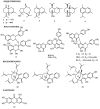Medicinal Potential of Garcinia Species and Their Compounds
- PMID: 33019745
- PMCID: PMC7582350
- DOI: 10.3390/molecules25194513
Medicinal Potential of Garcinia Species and Their Compounds
Abstract
Garcinia is a genus of Clusiaceae, distributed throughout tropical Asia, Africa, New Caledonia, Polynesia, and Brazil. Garcinia plants contain a broad range of biologically active metabolites which, in the last few decades, have received considerable attention due to the chemical compositions of their extracts, with compounds which have been shown to have beneficial effects in several diseases. Our work had the objective of reviewing the benefits of five Garcinia species (G. brasiliensis, G. gardneriana, G. pedunculata, G. cambogia, and G. mangstana). These species provide a rich natural source of bioactive compounds with relevant therapeutic properties and anti-inflammatory effects, such as for the treatment of skin disorders, wounds, pain, and infections, having demonstrated antinociceptive, antioxidant, antitumoral, antifungal, anticancer, antihistaminic, antiulcerogenic, antimicrobial, antiviral, vasodilator, hypolipidemic, hepatoprotective, nephroprotective, and cardioprotective properties. This demonstrates the relevance of the genus as a rich source of compounds with valuable therapeutic properties, with potential use in the prevention and treatment of nontransmissible chronic diseases.
Keywords: Clusiaceae; phytochemical compounds; therapeutic effects.
Conflict of interest statement
The authors declare no conflict of interest.
Figures
Similar articles
-
A Comprehensive Review of Garcinia pedunculata Roxb. and its Therapeutic Potential.Mini Rev Med Chem. 2021;21(20):3113-3143. doi: 10.2174/1389557521666210217094152. Mini Rev Med Chem. 2021. PMID: 33596803 Review.
-
Phytoconstituents and Biological Activities of Garcinia dulcis (Clusiaceae): A Review.Nat Prod Commun. 2017 Mar;12(3):453-460. Nat Prod Commun. 2017. PMID: 30549909 Review.
-
Phytochemicals and Biological Activities of Garcinia morella (Gaertn.) Desr.: A Review.Molecules. 2020 Dec 2;25(23):5690. doi: 10.3390/molecules25235690. Molecules. 2020. PMID: 33276654 Free PMC article. Review.
-
Garcinia macrophylla: a Promising Underutilized Source of Bioactive Compounds in the Amazonia - A Review.Plant Foods Hum Nutr. 2024 Mar;79(1):12-19. doi: 10.1007/s11130-023-01128-9. Epub 2024 Jan 9. Plant Foods Hum Nutr. 2024. PMID: 38191770 Review.
-
Alhagi: a plant genus rich in bioactives for pharmaceuticals.Phytother Res. 2015 Jan;29(1):1-13. doi: 10.1002/ptr.5222. Epub 2014 Sep 24. Phytother Res. 2015. PMID: 25256791 Review.
Cited by
-
Phytocompounds from Amazonian Plant Species against Acute Kidney Injury: Potential Nephroprotective Effects.Molecules. 2023 Sep 2;28(17):6411. doi: 10.3390/molecules28176411. Molecules. 2023. PMID: 37687240 Free PMC article. Review.
-
Effects of Hydroxycitric Acid Supplementation on Body Composition, Obesity Indices, Appetite, Leptin, and Adiponectin of Women with NAFLD on a Calorie-Restricted Diet.Int J Clin Pract. 2023 Jul 12;2023:6492478. doi: 10.1155/2023/6492478. eCollection 2023. Int J Clin Pract. 2023. PMID: 37476001 Free PMC article. Clinical Trial.
-
Caudiquinol: A Meroterpenoid with an Intact C20 Geranylgeranyl Chain Isolated from Garcinia caudiculata.Molecules. 2024 Jul 31;29(15):3613. doi: 10.3390/molecules29153613. Molecules. 2024. PMID: 39125018 Free PMC article.
-
Quality Evaluation of Dietary Supplements for Weight Loss Based on Garcinia cambogia.Nutrients. 2022 Jul 27;14(15):3077. doi: 10.3390/nu14153077. Nutrients. 2022. PMID: 35893931 Free PMC article.
-
Polyprenylated Benzoylphloroglucinols Isolated from Garcinia Species and Their Cytotoxic Effects on Cancer Cell Lines.ACS Omega. 2024 Oct 16;9(43):43689-43696. doi: 10.1021/acsomega.4c06030. eCollection 2024 Oct 29. ACS Omega. 2024. PMID: 39494031 Free PMC article.
References
-
- Kunle O.F., Egharevba H.O., Ahmadu P.O. Standardization of herbal medicines—A review. Int. J. Biodivers. Conserv. 2012;4:101–112. doi: 10.5897/IJBC11.163. - DOI
-
- Shameer P.S., Rameshkumar K.B., Mohanan N. Diversity of garcinia in the Western Ghats. Phytochemical perspective. India Jawaharlal Nehru Trop. Bot. Gard. Res. Inst. 2016:1–18.
-
- Ampofo S.A., Waterman P.G. Xanthones and neoflavonoids from two Asian species of Calophyllum. Phytochemistry. 1986;25:2617–2620. doi: 10.1016/S0031-9422(00)84521-5. - DOI
-
- Monache G.D., Monache F.D., Waterman P.G., Crichton E.G., De Lima R.A. Minor xanthones from Rheedia gardneriana. Phytochemistry. 1984;23:1757–1759. doi: 10.1016/S0031-9422(00)83485-8. - DOI
Publication types
MeSH terms
Substances
Grants and funding
LinkOut - more resources
Full Text Sources






